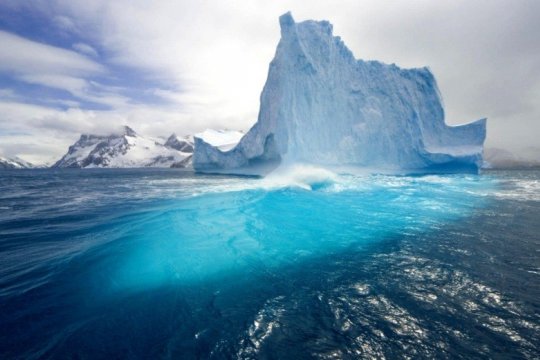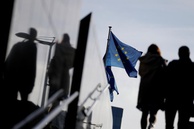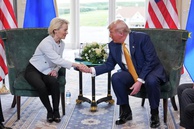According to Western media, the "struggle for the Arctic" is becoming ever more fierce. Moreover, this confrontation is unfolding much faster than expected.
In its recent publication the Swedish Aftonbladet wrote that since “climate change” has made the Arctic “more accessible, countries taking advantage of it to produce more fossil fuels.” Der Spiegel cites American experts as saying that "temperatures [in the Arctic region] are rising twice as fast compared to average statistics", while permafrost melting in some regions began "70 years earlier" than predicted. Meanwhile, the US Geological Service estimates the Arctic energy reserves at more than 400 billion barrels of the oil equivalent. The Arctic is home to at least 10% of the world's yet-to-be-discovered oil reserves, “and as much as 25% of gas,” Aftonbladet reports. In addition, in the medium and long-term perspective, the melting of polar ice makes routes through the Northwest Passage and the Russian Northern Sea Route (NSR) more attractive for commercial navigation, as these routes are , in some cases, are 1.5 - 2 times shorter than the currently used ones. As the number of mineral exploration and development projects grows, along with prospects for increasing shipping volumes, there is a need to strengthen security in the region. Therefore, many observers predict a further “militarization of the Arctic”. “The Arctic is a region whose significance is changing the geoeconomic and geopolitical situation in the whole world,” -Bloomberg reports.
The current strategic situation in the region is determined by three main trends. The "return" of Russia, the "re-evaluation" of strategy by the United States and the growing interest in China. In the opinion of some Western commentators, the natural from the geographic point of view dependence of the Arctic region on Russia is a geopolitical problem for Europe, Canada and the United States. Nearly half of the coast and the coastal zone of the Arctic belong to the territory of the Russian Federation and its special economic zone, which yields the country up to 15 percent of GDP. In March 2018, Vladimir Putin described the NSR as "key to the development of the Russian Arctic and the regions of the Far East." Given that the Russian leadership is fully aware of the challenges associated with such an agenda, Russia’s Decree of May 2018 sets realistic goals: to increase the cargo flow through the NSR by 2024 to 80 million tons. At present, traffic through the Northern Sea Route is considerably less intensive than that through the Suez Canal.
What western commentators are particularly worried about is (quite natural and geographically justified) Russia’s efforts to strengthen its northern borders. Restoration of military infrastructure in the region is being presented as a “return to the Cold War practices.” Moreover, there are open warnings that can be interpreted as threats. The June report of Chatham House says that “Russia should not assume that it can continue to freely develop the Arctic .... At present, Russia is determining the future of military activity in the Arctic. However, it’s time for the West and NATO to secure parity of potential in this region.” “We should not allow Moscow to continue to consider its military activity on the vast expanses of the region decisive” [i].
In May, the German Frankfurter Allgemeine Zeitung reported that Russia “was already far ahead” of other countries not only in the military, but also in the economic development of the Arctic. Nevertheless, the West believes that the current sanctions that restrict Russian access to oil exploration and production technologies in the severe conditions of the North force Russia to partially change its priorities and focus on developing LNG projects and transport corridors instead. And Russia has been successful at that, they say: the Russian icebreaking fleet is the world’s most numerous and most powerful. Three new ships have already been put into operation, "capable of breaking ice up to three meters thick." Such icebreakers will allow Russia to redirect part of the world's transport routes to the NSR in the foreseeable future. And by using ice-class LNG tankers, which are currently under construction, Russia gets the opportunity to “deliver gas to customers around the world”, without being dependent on the existing pipeline systems, Stern writes.
The United States is also showing interest in the economic opportunities which spring up as the polar ice melts. The incumbent administration has reversed Obama’s decision, banning the drilling of test wells off the coast of Alaska. Donald Trump “pays a lot of attention to the Arctic in words but take little action to this effect,” Bloomberg says, describing the Bering Strait as "a potential Persian Gulf of the future." Meanwhile, the US practical potential in the Arctic is still limited: it has 1-2 icebreakers, while Russia has 14. So far, there is no program for the development of the region: recently, Trump gave up on his initial plans to build new icebreakers.
In the meantime, many American experts believe that security remains Washington’s top priority in the Arctic. The Arctic joins together North America, Asia and Europe. Through this region, military experts fear, lies the shortest route for potential missile and air strikes against America from the Northern Hemisphere. Thus, Washington plans to strengthen missile defense and aviation forces. And this is not a new strategy. Back in January 2007, the United States adopted Directive No. 66 on National Security, which declared the presence of "broad and fundamental" interests in the Arctic region. It signals readiness "to act either independently or jointly with other states in order to protect these interests." In 2012, the US Secretary of State described her country as “a leading state in the high latitudes of the planet,” and Norway, a NATO ally, as “the capital of the Arctic” [ii]. Last October, Norway hosted the largest NATO military exercises since the end of the Cold War, called Trident Juncture, with the participation of up to 40 thousand servicemen from all countries of the alliance, as well as military personnel from two northern countries that are not members of NATO - Sweden and Finland. US Secretary of State, Mike Pompeo, recently described the Arctic as an "arena of rivalry between world powers." Pompeo did not forget to blame Russia for planning to “use force”, and China - for demonstrating a “model of aggressive behavior.” All this dispels any doubts that for NATO, the Arctic is becoming a strategic scene of military activity.
In addition to the United States, NATO maintains its presence in the Arctic region through its two other members, Canada and Norway. The latter owns the strategically important Svalbard archipelago. At the same time, there is mutual understanding among countries that are members of the Arctic Council regarding the importance of resolving security issues “solely between them.” Nevertheless, “Russia in Global Politics” remarks, the presence of an extensive and well-developed legal framework for regulating the Arctic does not prevent “an increasing number of countries” from trying to provide cooperation in the region with a wide “international dimension”.
In particular, the European Union has not been giving up on attempts to obtain the status of observer with the Arctic Council. While doing so, the EU has consistently cast doubt on the legal status of the NSR as a Russian national transport artery. The EU is also advocating an exceptional priority of norms of international law in the Arctic, primarily the 1982 UN Convention on the Law of the Sea, while “deliberately forgetting” about the country level of regulation [iii]. In contrast to Russia, the EU is pursuing ambitious plans for the development of a transport hub in Kirkenes, which is seen as an alternative to the ports of the Russian NSR. In 2018, the Norwegian city became the terminating point of a railway route from Europe to the Arctic. According to the Arctic Corridor Project, the route is to be built from the northern coast of Norway to the planned tunnel under the Gulf of Finland to Estonia, and then across Europe to Berlin. By connecting the Arctic Corridor with a transit route through the NSR, the EU hopes to transform Kirkenes into a major logistics hub for Chinese goods which are planned to be transported to Europe as part of the Polar Silk Road Project [iv]. But critics of this project rightfully fear that if the EU becomes an observer of the Arctic Council, it could provoke similar claims on the part of NATO.
China declared its interests in the Arctic in 2013, when it joined the Arctic Council [v] as an observer. Such a move sent the West into bewilderment. According to the Pentagon, Beijing artificially “appropriated” the status of an “Arctic state”. However, China has already opened research stations in Iceland and Svalbard with a view to explore the Arctic. In January 2018, Beijing unveiled the White Paper titled China's Arctic Policy. An analysis of the text gives grounds to consider Beijing's approach a multi-faceted one. On the one hand, the document contains passages that suggest China’s readiness to recognize the legal priority of the Arctic countries, their national level of regulation in the Arctic. However, some passages echo the point of view of the United States. [vi]
At present, China is promoting the above mentioned concept of the "Polar Silk Road", which aims to provide it with natural resources and alternative shipping routes for export purposes. According to estimates by the Chinese Institute for Polar Research, Arctic routes will account for 5 to 15 percent of China’s foreign trade by 2020 [vii]. Western experts are keeping a close eye on the progressive development of cooperation between China and Russia. Investors from China own shares in a number of large-scale industrial and infrastructure projects implemented by Russia beyond the Arctic Circle. One of such projects is Yamal-LNG, the gas reserves of which are estimated in the West higher than at "all US gasfields." According to Frankfurter Allgemeine Zeitung, "China’s ambitions in the region do not seem to disturb Moscow yet." Moreover, Russia is counting on Chinese investment in the NSR.
The main "battles" around the status of the Arctic are unravelling in the legal sphere. The debate is centered on two issues: the external borders of the continental shelf and its delimitation in the central part of the Arctic Ocean [viii], and freedom of navigation. The legal position of the Russian Federation, backed by geography, gives a “broad” definition of the boundaries of the NSR, explaining that this route follows more than one way and is not fixed. [Ix] Russia’s main foes on this issue are the United States and the EU. They do not recognize the priority rights of the Arctic states, primarily Russia and Canada, to regulate shipping in Arctic waters. Moscow's decisions to introduce a permit procedure for the passage of foreign ships and, in particular, warships, as well as a mandatory use of Russian icebreaking and piloted convoys, are considered as a loose interpretation of Art. 234 of the 1982 Convention [x].
In general, despite the fact that Russia and the United States have potentially common interests related to the desire of the polar countries to avoid “internationalization” of regional regulation issues, the Arctic is becoming another point of discord in a series of geopolitical differences around the globe. In May this year, the Arctic Council “for the first time in its history” failed to agree on a declaration on the results of its meeting. According to one report, the US opposed the clause on “the need to comply with the Paris Climate Agreement” [xi]. According to other reports, this was because the US accused China of promoting its economic and military interests in the region in an “inappropriate way” [xii].
Moscow is fully aware of the gains from the development of the Arctic at a qualitatively new level. The Russian leadership is also aware of the fact that this will require multibillion investments over many years. Not to mention efforts that will be required for the protection of national interests in one of the least developed regions of the planet. Russia's consistent position on this issue will undoubtedly yield economic fruit over time, but this fruit will have to be fought for.
The opinion of the author may not coincide with the position of the Editorial Board
[i] https://russian.rt.com/world/article/646608-arktika-britaniya-rossiya-doklad
[ii] http://expert.ru/2013/12/11/politicheskoe-poholodanie-idet-iz-arktiki/
[iii] https://www.globalaffairs.ru/number/Arkticheskie-nedorazumeniya-20044
[iv] https://regnum.ru/news/polit/2442095.html
[v] The Arctic Council was established in 1996. It consists of eight countries - Denmark, Iceland, Canada, Norway, Russia, USA, Finland and Sweden. A number of countries and organizations have or claim observer status.
[vi] http://www.globalaffairs.ru/global-processes/Arkticheskie-ambitcii-Podnebesnoi-19711.
[vii] https://foreignpolicy.com/2018/05/01/chinas-ready-to-cash-in-on-a-melting-arctic/
[ix] Gavrilov V.V., Legal status of the Northern Sea Route of the Russian Federation \ Journal of Russian Law No. 2, 2015.
[x] https://russiancouncil.ru/analytics-and-comments/analytics/kuda-vedet-severnyy-morskoy-put/
[xi] https://p.dw.com/p/3I55A
[xii] https://inosmi.ru/politic/20190729/245534915.html
read more in our Telegram-channel https://t.me/The_International_Affairs

 0:13 16.08.2019 •
0:13 16.08.2019 •



























